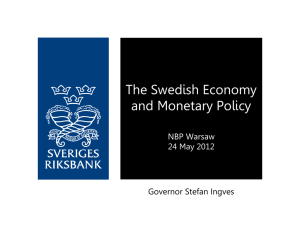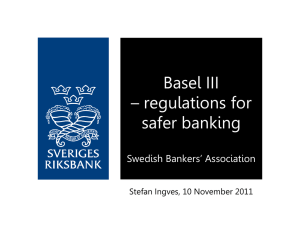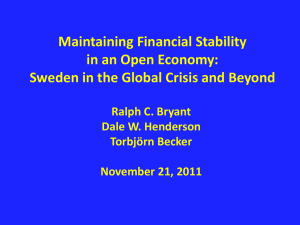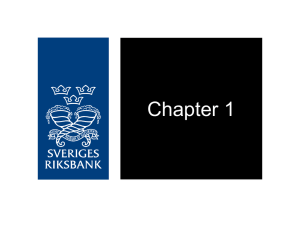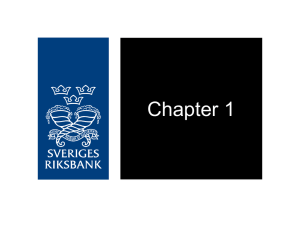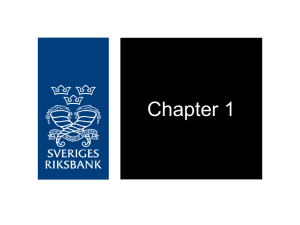Per cent
advertisement
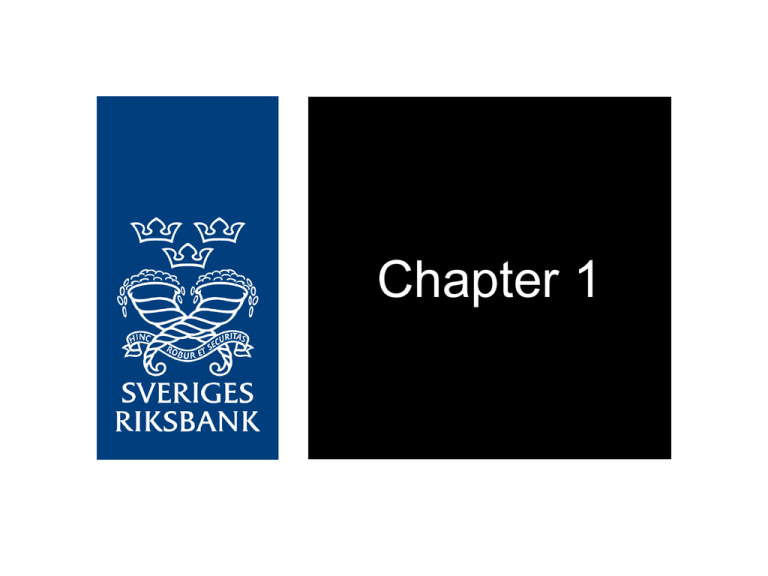
Chapter 1 Five-year CDS premiums Basis points 1 600 1 400 1 200 1 000 800 600 400 200 0 jul-08 jan-09 Greece Chart: 1:1. jul-09 Ireland jan-10 jul-10 Portugal jan-11 jul-11 Spain Source: Reuters EcoWin Interest rates on ten-year government bonds Per cent 18 16 14 12 10 8 6 4 2 jul-08 jan-09 Greece Chart: 1:2. jul-09 Ireland jan-10 jul-10 Portugal jan-11 jul-11 Spain Source: Reuters EcoWin Yield curve for Greek government bonds Per cent 30 25 20 15 10 5 0 2 år 3 år 5 år 2010-12-30 Diagram 1:3. 7 år 10 år 15 år 2011-05-24 Källa Reuters Ecowin Refinancing needs of countries and banks for 2011 Percentage of GDP Chart: 1:4 Sources: Dealogic, Reuters EcoWin and the Riksbank Exposure of international banks Index, second quarter 2008=100, euro 120 110 100 90 80 70 60 50 jun-07 Chart 1:5. dec-07 jun-08 dec-08 Greece Ireland jun-09 Portugal dec-09 jun-10 dec-10 Spain Source: Bank for International Settlements Government debt as a percentage of GDP (vertical axis) and the difference between the nominal interest rate and nominal GDP growth (horizontal axis) Per cent Chart 1:6. Sources: IMF, Eurostat and the Riksbank Signs of search for yield Left scale per cent and right scale index 18 270 16 240 14 210 12 180 10 150 8 120 6 90 4 60 2 30 0 jan-09 jul-09 jan-10 jul-10 jan-11 0 jul-11 Credit spread high-yield bonds - United States, (left scale) Commodities (right scale) Equity index for emerging markets (right scale) Chart 1:7. Sources: Reuters Ecowin and The Economist International stress index Chart 1:8. Sources: Reuters EcoWin, Bloomberg and the Riksbank European banks’ bond issuance EUR billion 400 350 300 250 200 150 100 50 0 Q1 Q2 Q3 Q4 Q1 2007 Covered bonds Chart 1:9. Q2 Q3 Q4 Q1 2008 Unsecured bonds Q2 Q3 2009 Q4 Q1 Q2 Q3 Q4 Q1 2010 Q2 2011 Government guaranted bonds Source: Dealogic Comparison of 5-year CDS premiums for banks Basis points Chart: 1:10. Source: Bloomberg Maturity profile of bonds issued by European banks EUR billion 120 100 80 60 40 20 0 5 6 7 8 9 10 11 12 1 2 3 4 5 6 7 8 9 10 11 12 1 2 3 4 5 6 7 8 9 10 11 12 2011 Covered bonds Chart 1:11. 2012 Unsecured bonds 2013 Government guaranted bonds Source: Dealogic Central banks’ balance sheets Percentage of GDP 30 25 20 15 10 5 0 07 08 ECB Chart 1:12. 09 Bank of England 10 Federal Reserve 11 12 The Riksbank Sources: National central banks The risk premium on the interbank market Basis points 100 90 80 70 60 50 40 30 20 10 0 jan-08 jul-08 jan-09 United States Chart 1:13. jul-09 jan-10 United Kingdom jul-10 Euro Area jan-11 jul-11 Sweden Sources: Reuters Ecowin and Bloomberg Maturity structures for non-financial companies’ syndicated loans SEK billion 250 200 150 100 50 0 11 Chart 1:14. 12 13 14 15 16 17 18 19 20 21 22 23 24 25 Source: Dealogic Maturity structures for non-financial companies’ market funding SEK billion Chart 1:15. Source: Dealogic US corporate bond issuance USD billions 1200 1000 800 600 400 200 0 96 97 98 99 00 01 02 03 Investment grade Chart 1:16. 04 05 06 07 08 09 10 11 High-yield Source: SIFMA Difference between the short-term interbank rate and the Riksbank’s repo rate Basis points 70 60 50 40 30 20 10 0 2002 Chart R1:1. 2003 2004 2005 2006 2007 2008 2009 2010 2011 2012 Source: Reuters Ecowin Grey area in detail Basis points 70 60 50 40 30 20 10 0 jan-10 Chart R1:1. apr-10 jul-10 okt-10 jan-11 apr-11 jul-11 Source: Reuters Ecowin Monthly volatility in the difference between the tomorrow next rate and the repo rate Basis points 20 15 10 5 0 2002 2003 2004 2005 2006 IMM month Chart R1.2. 2007 2008 2009 2010 2011 Non-IMM month Sources: Reuters EcoWin and the Riksbank Cost of converting long-term borrowing in euros into Swedish kronor via a currency swap Basis points 60 50 40 30 20 10 0 -10 2002 Chart R1:3. 2003 2004 2005 2006 2007 2008 2009 2010 2011 Source: Bloomberg Chapter 2 Lending of the Swedish banking groups by borrower category, March 2011 Per cent of total lending Chart 2:1. Sources: Bank reports and the Riksbank Lending of the Swedish banking groups by geographical area, March 2011 Per cent of total lending Chart 2:2. Sources: Bank reports and the Riksbank Prices for single-family dwellings and tenant-owned apartments Index, January 2008 = 100 Chart 2:3. Källor: SCB, Mäklarstatstik och Valueguard AB Household borrowing Monthly change on an annual rate and three-month moving average, percentage 20 18 16 14 12 10 8 6 4 2 0 02 03 04 05 Change in borrowing Chart 2:4. 06 07 08 09 10 11 Change in borrowing, three-month moving average Source: The Riksbank Households’ new loans broken down by fixed interest period Per cent 100% 80% 60% 40% 20% 0% 96 97 98 99 Variable rate Chart 2:5. 00 01 02 03 04 Fixed rate < 5 years 05 06 07 08 09 10 11 Fixed rate > 5 years Source: The Riksbank Lending to households and threemonth mortgage rates Annual percentage change and per cent Chart 2:6. Source: The Riksbank Household debt and post-tax interest expenditure Per cent of disposable income Chart 2:7. Sources: The National Board of Housing, Building and Planning and Statistics Sweden Households’ gross debts, assets and saving as a share of disposable income Per cent Chart 2:8. Sources: Statistics Sweden and the Riksbank Corporate borrowing from credit institutions and fixed gross investment Annual percentage change Chart 2:9. Sources: Statistics Sweden and the Riksbank Cororate credit gap Per cent 15 10 5 0 -5 -10 -15 -20 99 Chart 2:10. 00 01 02 03 04 05 06 07 08 09 10 11 Sources: Statistics Sweden and the Riksbank Interest coverage ratio in Nordic listed companies Ratio 8 7 6 5 4 3 2 1 0 -1 03 04 05 Sweden Chart 2:11. 06 Denmark 07 Norway 08 09 10 Finland Sources: Bloomberg and the Riksbank The number of bankruptcies broken down by industry Twelve-month moving average 160 140 120 100 80 60 40 20 0 95 97 99 Manufacturing Transport Wholesale and retail trade Chart 2:12. 01 03 05 Construction Property management Hotel and restaurants 07 09 11 IT-telecom Services Source: Statistics Sweden Transaction volumes on the Swedish commercial property market SEK billion 160 140 120 100 80 60 40 20 0 99 00 01 02 03 04 Swedish investors Chart 2:13. 05 06 07 08 09 10 Foreign investors Source: Savills Average yield levels for modern office premises in city centres Per cent 16 14 12 10 8 6 4 2 0 86 88 90 92 Stockholm Chart 2:14. 94 96 Göteborg 98 00 Malmö 02 04 06 08 10 12 Five-year government bond Sources: Newsec and the Riksbank Real house prices Index, March 2004 = 100 160 150 140 130 120 110 100 90 04 05 06 Sweden Chart 2:15. 07 Denmark 08 Norway 09 10 11 Finland Sources: Bank for International Settlement, Bank of Finland, Reuters EcoWin, Statistics Sweden and the Riksbank Expected default frequency (EDF) Per cent 3,0 2,5 2,0 1,5 1,0 0,5 0,0 05 06 07 Sweden Chart 2:16. 08 Denmark 09 Norway 10 11 12 Finland Source: Moody's KMV GDP Annual percentage change 15 10 5 0 -5 -10 -15 -20 -25 99 00 01 02 03 Estonia Chart 2:17. 04 05 Latvia 06 07 08 09 10 11 12 Lithuania Source: Reuters EcoWin Real exchange rates Index, 2000 = 100 140 130 120 110 100 90 80 01 02 03 04 Estonia Chart:2:18. 05 06 07 Latvia 08 09 10 11 12 Lithuania Source: Bank for International Settlements Households' and companies' debts in relation to GDP Per cent 140 120 100 80 60 40 20 0 95 96 97 98 99 00 01 Estonia Chart 2:19. 02 03 04 Latvia 05 06 07 08 09 10 11 Lithuania Sources: The national central banks and Reuters EcoWin Late payments Per cent of lending 20 18 16 14 12 10 8 6 4 2 0 01 Chart 2:20. 02 03 04 05 Estonia (more than 60 days) Lithuania (more than 60 days) 06 07 08 09 10 11 Latvia (more than 90 days) 12 Sources: Eesti Pank, Financial and Capital Market Commission och Lietuvos Bankas Chapter 3 Bank assets in relation to GDP June 2010 Per cent Chart 3:1. Sources: ECB, The Swiss National Bank and the Riksbank The total assets of the major Swedish banks, December 2010 SEK billion 12 000 10 000 8 000 6 000 4 000 2 000 0 Handelsbanken Nordea Sweden Chart 3:2. SEB Swedbank Total Abroad Sources: Bank reports and the Riksbank Breakdown of the major Swedish banks’ profits before loan losses, 2010 Per cent Chart 3:3. Sources: Bank reports and the Riksbank Earnings before loan losses and loan losses in the major Swedish banks, Mars 2011 Totalled over four quarters, SEK billion, fixed prices 120 100 80 60 40 20 0 Profit before loan losses Chart 3:4. dec-12 dec-10 dec-08 dec-06 dec-04 dec-02 dec-00 dec-98 dec-96 dec-94 dec-92 dec-90 -20 Loan losses Sources: Bank reports and the Riksbank The major swedish banks' income Rolling four quarters, SEK billion 250 200 150 100 50 0 08:3 08:4 Other income Chart 3:5. 09:1 09:2 09:3 Net result of financial items 09:4 10:1 10:2 10:3 Net commission income 10:4 11:1 Net interest income Sources: Bank reports and the Riksbank The major Swedish banks’ margins on new mortgages in Sweden Per cent Chart 3:6. Sources: Bank reports and the Riksbank The major Swedish banks’ profitability Four-quarter moving average, per cent 25 20 15 10 5 0 04:4 05:4 06:4 Return on equity Chart 3:7. 07:4 08:4 09:4 10:4 11:4 Average return on equity Sources: Bank reports and the Riksbank Swedish major banks' lending to the public in the Baltic countries EUR billion and per cent Chart 3:8. Sources: Bank reports and the Riksbank Market shares of lending in the Baltic countries Per cent Chart 3:9. Sources: Bank reports and the Riksbank The Swedish banks' loan losses Percentage of lending at the start of the respective quarters Chart 3:10. Sources: Bank reports and the Riksbank The major Swedish banks’ loan losses per quarter SEK billion Chart 3:11. Sources: Bank reports and the Riksbank Core Tier 1 capital ratios of Swedish and foreign banks, according to Basel II, December 2010 Per cent Chart 3:12. Sources: Bank reports and the Riksbank Core Tier 1 capital ratios according to Basel II Per cent 16 14 12 10 8 6 4 2 0 Swedbank Nordea 08:4 Chart 3:13. 09:4 SEB 10:4 Handelsbanken 11:1 Source: Bank reports and the Riksbank Risk weighting on mortgages according to Basel II Per cent 60 50 40 30 20 10 Chart 3:14. Slovakia Latvia Hungary Spain Lithuania Estonia Italy Germany Netherlands Greece Norway Denmark Finland Belgium Sweden 0 Sources: National central banks and the Riksbank The major Swedish banks' funding, March 2011 Per cent Chart 3:15. Sources: Bank reports and the Riksbank Government-guaranteed borrowing and the Riksbank’s lending to the major Swedish banks Left axis: SEK billion, right axis: percentage of Sweden's GDP Chart 3:16. Sources: Bank reports, Statistics Sweden and the Riksbank The market funding of the major Swedish banks via Swedish parent and subsidiary companies per SEK and foreign currencies SEK billion 3 000 2 500 2 000 1 500 1 000 500 0 98 99 00 01 02 03 04 Foreign Currency Chart 3:17. 05 06 07 08 09 10 11 12 SEK Sources: Statistics Sweden and the Riksbank The major Swedish banks’ lending funded by foreign currency securities issued in Sweden Percentage of the major Swedish banks’ market funding in foreign currency via Swedish parent and subsidiary companies Lending, Latvia and Lithuania 4% Lending, other countries 26% Swedish lending 43% Lending, euro area countries 24% Swedish lending in foreign currency 3% Chart 3:19. Sources: Statistics Sweden and the Riksbank Holders of Swedish covered bonds SEK billion 1 600 1 200 800 400 0 Non-residents Chart 3:19. Banks Insurance companies Other Sources: Statistics Sweden and the Riksbank Funding in US dollars for banks in the euro area and the Fed’s lending to other central banks USD billions Chart B3:1. Sources: Bank for international settlements, Federal Reserve and the Riksbank Percentage of funding through securities with original time to maturity of less than one year in the Swedish banking system Per cent Chart B3:2. Source: The Riksbank The major banks’ funding from deposits from the public and securities issued, by currency, per December 2010 Per cent 100% 80% 60% 40% 20% 0% Deposits Issued securities SEK Chart B3:3 EUR USD Other Sources: Bank reports and the Riksbank The major Swedish banks’ assets in USD per December 2010 SEK billion 600 500 400 300 200 100 0 Nordea Financial assets Chart B3:4. SEB Handelsbanken Lending/Loans to the public Swedbank Summa Lending interbank/ Loans to credit institutions Sources: Bank reports and the Riksbank Contracyclical capital buffers in the Nordic countries Per cent 3,0 2,5 2,0 1,5 1,0 0,5 0,0 81 83 85 87 89 Sweden Chart B3:5 91 93 95 Finland 97 99 Norway 01 03 05 07 09 11 Denmark Sources: Reuters EcoWin and the Riksbank Contracyclical capital buffers in the Baltic countries Per cent 3,0 2,5 2,0 1,5 1,0 0,5 0,0 94 95 96 97 98 99 00 Estonia Chart B3:6 01 02 03 Latvia 04 05 06 07 08 09 10 11 Lithuania Sources: Reuters EcoWin and the Riksbank Contracyclical capital buffers for Swedish banks Per cent 3,0 2,5 2,0 1,5 1,0 0,5 0,0 00 01 02 03 Swedbank Chart B3:7 04 05 SEB 06 07 Handelsbanken 08 09 10 11 Nordea Sources: The Riksbank and banks’ annual reports Contracyclical capital buffers without ceiling in the Nordic countries Percent 9 8 7 6 5 4 3 2 1 0 81 83 85 87 89 91 Sweden Chart B3:8 93 95 Finland 97 99 Norway 01 03 05 07 09 11 Denmark Sources: Reuters EcoWin and the Riksbank Contracyclical capital buffers without ceiling in the Baltic countries Per cent 9 8 7 6 5 4 3 2 1 0 94 95 96 97 98 99 00 01 Estonia Chart B3:9 02 03 Latvia 04 05 06 07 08 09 10 11 Lithuania Sources: Reuters EcoWin and the Riksbank Chapter 4 Earnings before loan losses and loan losses in the major Swedish banks, March 2011 Totalled over four quarters, SEK billion, fixed prices Chart 4:1. Sources: Bank reports, SME Direkt and the Riksbank Loan losses levels per bank and year in the main scenario Per cent Chart 4:2. Source: The Riksbank Distribution of loan losses per region in the period 2010–2013 in the main scenario SEK billion Chart 4:3. Source: The Riksbank Tier 1 capital ratio of the major Swedish bank with the lowest ratio after another Swedish major bank has defaulted on payments Per cent 9 8 7 6 5 4 3 2 1 0 2000 Chart 4:4. 2001 2002 2003 2004 2005 2006 2007 2008 2009 2010 2011 Source: The Riksbank GDP for Sweden in the stress test and in the main scenario SEK billions, fixed prices 4 000 3 500 3 000 2 500 2 000 1 500 1 000 500 0 1997 1999 2001 2003 Main scenario Chart 4:5. 2005 2007 2009 2011 2013 Stress scenario Sources: Statistics Sweden and the Riksbank Expected default frequency (EDF) for the Swedish non-financial companies in the stress test and in the main scenario Per cent 2,5 2,0 1,5 1,0 0,5 0,0 00 01 02 03 04 05 06 07 EDF, stress scenario Chart 4:6. 08 09 10 11 12 13 14 EDF, main scenario Sources: Moody's KMV and the Riksbank The major Swedish banks’ core Tier 1 capital ratios according to Basel II and Basel III, initially and in the stress test Per cent 16% 14% 12% 10% 8% 6% 4% 2% 0% 11 Kv1 11 12 13 Handelsbanken Chart 4:7. 11 Kv1 11 12 Nordea 13 11 Kv1 11 12 SEB 13 11 Kv1 11 12 13 Swedbank Source: The Riksbank Factors that contribute to changes in the banks’ core Tier 1 capital ratios according to Basel III in the stress test Per cent Chart 4:8. Source: The Riksbank The Riksbank’s structural liquidity measurement for the major Swedish banks compared with the average for a selection of European banks Stable funding in relation to illiquid assets, per cent Chart 4:9. Source: Liquidatum and the Riksbank Survival period for the major Swedish banks in the stressed scenario, compared with the average for a selection of European banks Number of months Chart 4:10. Sources: Liquidatum and the Riksbank
